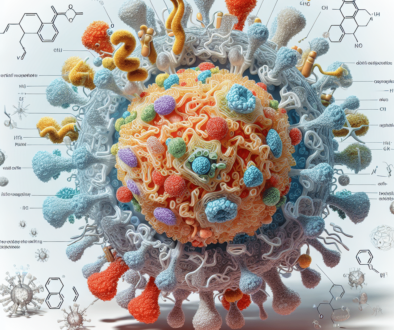Sialic Acid: Breaking Down Its Antiviral Effects
-
Table of Contents
- Sialic Acid: Unveiling Its Potent Antiviral Properties
- Understanding Sialic Acid
- The Dual Role of Sialic Acid in Viral Infections
- Facilitating Viral Entry
- Inhibiting Viral Spread
- Exploiting Sialic Acid’s Antiviral Effects in Therapeutics
- Neuraminidase Inhibitors
- Sialidase-Resistant Molecules
- Case Studies and Clinical Trials
- Influenza Treatment
- Emerging Viral Threats
- Conclusion: The Significance of Sialic Acid in Antiviral Defense
- Discover ETprotein’s High-Quality Protein Products
Sialic Acid: Unveiling Its Potent Antiviral Properties

Sialic acid, a term that may not be widely recognized outside scientific circles, plays a crucial role in the field of virology and immunology. This naturally occurring carbohydrate, found on the surfaces of cells, is more than just a structural element. It is a key player in the interaction between host cells and pathogens, particularly viruses. In this article, we delve into the antiviral effects of sialic acid, exploring how it can both facilitate and inhibit viral infections, and how this knowledge can be harnessed for therapeutic purposes.
Understanding Sialic Acid
Sialic acid is a generic term for a family of derivatives of neuraminic acid, an acidic sugar with a nine-carbon backbone. It is commonly found at the outermost end of glycan chains on the surface of cells and soluble proteins. The most common form of sialic acid in humans is N-acetylneuraminic acid (Neu5Ac).
- Location: Sialic acids are predominantly located on the cell membranes of vertebrates and higher invertebrates.
- Function: They play a significant role in cellular recognition processes, including cell-to-cell communication and pathogen-host interactions.
- Variability: Over 50 different sialic acids have been identified, with variations in their structure leading to different functional properties.
The Dual Role of Sialic Acid in Viral Infections
Sialic acid’s relationship with viruses is complex, as it can act both as a receptor for virus entry and as a shield against immune detection.
Facilitating Viral Entry
Many viruses, including influenza viruses, parainfluenza viruses, and coronaviruses, utilize sialic acid as a receptor to gain entry into host cells. The viral surface proteins, such as hemagglutinin in the case of influenza, bind to sialic acid residues, initiating the infection process.
- Influenza: The influenza virus binds to sialic acid residues on the host respiratory epithelium to establish infection.
- Coronaviruses: Some coronaviruses have been shown to interact with sialic acids, although this is less well understood than their primary receptor, angiotensin-converting enzyme 2 (ACE2).
Inhibiting Viral Spread
Conversely, sialic acid-containing molecules can act as decoys, preventing viruses from binding to actual host cells. This antiviral strategy is employed by some therapeutic agents that mimic the structure of sialic acid to intercept and neutralize viruses.
- Decoy Receptors: Synthetic sialic acid analogs can serve as competitive inhibitors, binding to viral particles and preventing them from attaching to host cells.
- Role in Immune Evasion: Sialic acids can mask the underlying glycan structures on host cells, helping to evade recognition by the immune system’s natural killer (NK) cells.
Exploiting Sialic Acid’s Antiviral Effects in Therapeutics
The understanding of sialic acid’s role in viral infections has led to the development of antiviral drugs and treatments that target these interactions.
Neuraminidase Inhibitors
Neuraminidase inhibitors, such as oseltamivir (Tamiflu) and zanamivir (Relenza), are a class of antiviral drugs that block the function of viral neuraminidase, an enzyme that cleaves sialic acid residues. By inhibiting neuraminidase, these drugs prevent the release of new viral particles from infected cells, thereby limiting the spread of infection.
- Mode of Action: Neuraminidase inhibitors competitively bind to the active site of the viral neuraminidase enzyme.
- Effectiveness: These drugs are most effective when administered early in the course of influenza infection.
Sialidase-Resistant Molecules
Researchers are also exploring the use of sialidase-resistant sialic acid analogs that can serve as irreversible inhibitors of viral neuraminidase or as non-cleavable receptors that trap viruses.
- Development: Novel compounds are being synthesized and tested for their ability to resist neuraminidase cleavage.
- Potential: These molecules have the potential to serve as long-lasting antivirals with broad-spectrum activity.
Case Studies and Clinical Trials
Several studies have demonstrated the potential of sialic acid-based therapies in treating viral infections.
Influenza Treatment
Oseltamivir and zanamivir have been widely used in clinical settings to treat and prevent influenza. Their efficacy has been demonstrated in numerous clinical trials and real-world case studies, particularly during influenza outbreaks and pandemics.
Emerging Viral Threats
Research into sialic acid interactions has also been crucial in understanding emerging viruses, such as the novel coronaviruses responsible for SARS, MERS, and COVID-19. While sialic acid’s role in these infections is less direct, it has provided insights into potential therapeutic targets.
Conclusion: The Significance of Sialic Acid in Antiviral Defense
Sialic acid is a remarkable molecule with a significant impact on viral pathogenesis and host defense mechanisms. Its dual role as a facilitator of viral entry and a component of antiviral strategies makes it a critical focus for research and drug development. By continuing to explore sialic acid’s interactions with viruses, scientists can develop more effective antiviral therapies that can prevent and treat a wide range of viral infections.
Discover ETprotein’s High-Quality Protein Products
In the quest for improved health and wellness, ETprotein offers a range of protein products that can support your nutritional needs. Whether you’re looking for organic plant-based proteins or high-purity L-(+)-Ergothioneine for various applications, ETprotein has you covered. Their commitment to quality and customer satisfaction makes them a go-to source for proteins that cater to the nutraceutical, pharmaceutical, and food and beverage industries.
About ETprotein:
ETprotein, a reputable protein and L-(+)-Ergothioneine (EGT) Chinese factory manufacturer and supplier, is renowned for producing, stocking, exporting, and delivering the highest quality organic bulk vegan proteins and L-(+)-Ergothioneine. They include Organic rice protein, clear rice protein, pea protein, clear pea protein, watermelon seed protein, pumpkin seed protein, sunflower seed protein, mung bean protein, peanut protein, and L-(+)-Ergothioneine EGT Pharmaceutical grade, L-(+)-Ergothioneine EGT food grade, L-(+)-Ergothioneine EGT cosmetic grade, L-(+)-Ergothioneine EGT reference grade and L-(+)-Ergothioneine EGT standard. Their offerings, characterized by a neutral taste, non-GMO, allergen-free attributes, with L-(+)-Ergothioneine purity over 98%, 99%, cater to a diverse range of industries. They serve nutraceutical, pharmaceutical, cosmeceutical, veterinary, as well as food and beverage finished product distributors, traders, and manufacturers across Europe, USA, Canada, Australia, Thailand, Japan, Korea, Brazil, and Chile, among others.
ETprotein specialization includes exporting and delivering tailor-made protein powder and finished nutritional supplements. Their extensive product range covers sectors like Food and Beverage, Sports Nutrition, Weight Management, Dietary Supplements, Health and Wellness Products, and Infant Formula, ensuring comprehensive solutions to meet all your protein needs.
As a trusted company by leading global food and beverage brands and Fortune 500 companies, ETprotein reinforces China’s reputation in the global arena. For more information or to sample their products, please contact them and email sales(at)ETprotein.com today.














